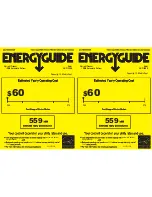
14
Once milkstone has formed, it is very difficult to remove.
Without using the correct product and procedure, it is
nearly impossible to remove a thick layer of milkstone.
(NOTE: general purpose cleaners DO NOT remove
milkstone.) This can lead to high bacteria counts and a
food safety dilemma.
IT IS BEST TO CONTROL MILKSTONE ON A DAILY
BASIS BEFORE IT CAN BECOME A SIGNIFICANT FOOD
SAFETY PROBLEM.
In addition to food safety, milkstone can cause premature
wear to machine parts which can add to costs for replace-
ment parts or possibly more expensive repairs if worn
machine parts are not replaced once they have become
excessively worn.
IMPORTANT DIFFERENCES BETWEEN CLEANING
AND SANITIZING
CLEANING vs. SANITIZING
It is important to distinguish between cleaning and sanitiz-
ing. Although these terms may sound synonymous, they
are not. BOTH are required for adequate food safety and
proper machine maintenance.
CLEANING
•
Is the removal of soil materials from a surface.
•
Is a prerequisite for effective sanitizing.
NOTE
An UNCLEAN surface will harbor bacteria that can
defy sanitizing efforts.
Bacteria can develop and resist sanitizing efforts within a
layer of soil material (milkstone). Thorough cleaning pro-
cedures that involve milkstone removal are critical for
operators of frozen dessert machines.
SANITIZING
•
Kills bacteria.
•
Can be effective on clean surfaces only.
NOTE
Using a SANITIZER on an unclean surface will not
guarantee a clean and safe frozen dessert machine.
PROPER DAILY MAINTENANCE: THE ONLY WAY TO
ASSURE FOOD SAFETY AND PRODUCT QUALITY
Proper daily maintenance can involve a wide variety of
products and procedures. Overall, the products and pro-
cedures fall into three separate categories. (Please note
that this is a brief overview intended for informational
purposes only.)
1.
CLEANING – This involves draining mix from the
freezer barrel and rinsing the machine with water.
Next, a cleaner is run through the machine. Then,
the machine is disassembled and removable
parts are taken to the sink for cleaning.
2.
MILKSTONE REMOVAL – Since almost all
cleaners do not have the ability to remove
milkstone, the use of a delimer becomes
necessary. Although this procedure may not be
needed on a daily basis, it will usually follow the
cleaning procedure. It requires letting a delimer
solution soak in the machine for an extended
period of time. Individual parts are also soaked in
a deliming solution for an extended period of time
(more about delimers in Additional Information).
3.
SANITIZING – After the machine has been cleaned
and contains no milkstone, the machine is
reassembled. Then an FDA approved sanitizing
solution is run through the machine to kill bacteria.
The machine is then ready for food preparation.
As a recommended cleaner and sanitizer for your frozen
dessert machine, Stera-Sheen has proven to be one of the
best daily maintenance products for:
•
CLEANING – Thorough removal of all solids
including butterfat and milk fat.
•
MILKSTONE REMOVAL – Complete removal of
milkstone.
•
SANITIZING – FDA approved no rinse sanitizer
for food contact surfaces.
ADDITIONAL INFORMATION
THE USE OF DELIMERS
A delimer is a strong acid that has the ability to dissolve
milkstone. This type of chemical may become necessary
once high levels of milkstone have developed. While
these products are very effective for removing HIGH
levels of milkstone, they are not ideal for two reasons:
1.
PRODUCT SAFETY – Strong acids are dangerous
chemicals and handling them requires safety
2.
MACHINE DAMAGE – Strong acids will attack
metal and rubber causing premature wear of
parts. The use of a delimer needs to be closely
monitored to avoid damage to machine surfaces
and parts.
With proper daily use of Stera-Sheen or its equivalent,
there is no need for the use of a DELIMER.
DO NOT USE BLEACH
•
BLEACH HAS ABSOLUTELY NO CLEANING
PROPERTIES.
•
BLEACH IS CORROSIVE. It can and will damage
components of the machine causing premature
wear and metal corrosion.
GENERAL PURPOSE CLEANERS
General purpose cleaners do not have the ability to re-
move milkstone. Milkstone will become a problem if not
remedied with additional products and procedures.
Summary of Contents for SO212
Page 1: ...Model SO212 OPERATORS MANUAL Manual No 513610 Rev 2...
Page 2: ......
Page 12: ...6...
Page 22: ...16...
Page 28: ...22...











































